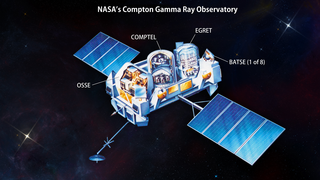Fermi Traces a Celestial Spirograph
NASA's Fermi Gamma-ray Space Telescope orbits our planet every 95 minutes, building up increasingly deeper views of the universe with every circuit. Its wide-eyed Large Area Telescope (LAT) sweeps across the entire sky every three hours, capturing the highest-energy form of light — gamma rays — from sources across the universe. These range from supermassive black holes billions of light-years away to intriguing objects in our own galaxy, such as X-ray binaries, supernova remnants and pulsars.
Now a Fermi scientist has transformed LAT data of a famous pulsar into a mesmerizing movie that visually encapsulates the spacecraft's complex motion.
Pulsars are neutron stars, the crushed cores of massive suns that destroyed themselves when they ran out of fuel, collapsed and exploded. The blast simultaneously shattered the star and compressed its core into a body as small as a city yet more massive than the sun. One pulsar, called Vela, shines especially bright for Fermi. It spins 11 times a second and is the brightest persistent source of gamma rays the LAT sees.
The movie renders Vela's position in a fisheye perspective, where the middle of the pattern corresponds to the central and most sensitive portion of the LAT's field of view. The edge of the pattern is 90 degrees away from the center and well beyond what scientists regard as the effective limit of the LAT's vision. The movie tracks both Vela's position relative to the center of the LAT's field of view and the instrument's exposure of the pulsar during the first 51 months of Fermi's mission, from Aug. 4, 2008, to Nov. 15, 2012.
The pattern Vela traces reflects numerous motions of the spacecraft. The first is Fermi's 95-minute orbit around Earth, but there's another, subtler motion related to it. The orbit itself also rotates, a phenomenon called precession. Similar to the wobble of an unsteady top, Fermi's orbital plane makes a slow circuit around Earth every 54 days.
In order to capture the entire sky every two orbits, scientists deliberately nod the LAT in a repeating pattern from one orbit to the next. It first looks north on one orbit, south on the next, and then north again. Every few weeks, the LAT deviates from this pattern to concentrate on particularly interesting targets, such as eruptions on the sun, brief but brilliant gamma-ray bursts associated with the birth of stellar-mass black holes, and outbursts from supermassive black holes in distant galaxies.
The Vela movie captures one other Fermi motion. The spacecraft rolls to keep the sun from shining on and warming up the LAT's radiators, which regulate its temperature by bleeding excess heat into space.
Watch this video on YouTube.
The Vela pulsar outlines a fascinating pattern in this movie showing 51 months of position and exposure data from Fermi's Large Area Telescope (LAT). The pattern reflects numerous motions of the spacecraft, including its orbit around Earth, the precession of its orbital plane, the manner in which the LAT nods north and south on alternate orbits, and more. The movie renders Vela's position in a fisheye perspective, where the middle of the pattern corresponds to the central and most sensitive portion of the LAT's field of view. The edge of the pattern is 90 degrees away from the center and well beyond what scientists regard as the effective limit of the LAT's vision. Better knowledge of how the LAT's sensitivity changes across its field of view helps Fermi scientists better understand both the instrument and the data it returns.
Credit: NASA/DOE/Fermi LAT Collaboration
For complete transcript, click here.

This image compresses the Vela movie sequence into a single snapshot by merging pie-slice sections from eight individual frames.
Credit: NASA/DOE/Fermi LAT Collaboration

The LAT's sensitivity to gamma rays is greatest in the center of its wide field of view and decreases toward the edge. LAT scientists regard the effective limit of the instrument's field of view to be 78.5 degrees (red circle) from its center.
Credit: NASA/DOE/Fermi LAT Collaboration

Final still from video.
Credit: NASA/DOE/Fermi LAT Collaboration
Original frame sequence.
Credit: NASA/DOE/Fermi LAT Collaboration
For More Information
Credits
Please give credit for this item to:
NASA's Goddard Space Flight Center. However, individual items should be credited as indicated above.
-
Animator
- Eric Charles (SLAC National Accelerator Laboratory)
-
Video editor
- Scott Wiessinger (USRA)
-
Producer
- Scott Wiessinger (USRA)
-
Scientist
- Eric Charles (SLAC National Accelerator Laboratory)
-
Writer
- Francis Reddy (Syneren Technologies)
Release date
This page was originally published on Wednesday, February 27, 2013.
This page was last updated on Wednesday, May 3, 2023 at 1:52 PM EDT.
Missions
This page is related to the following missions:Series
This page can be found in the following series:Tapes
The media on this page originally appeared on the following tapes:-
Fermi Vela Cosmic Spirograph
(ID: 2013022)
Tuesday, February 26, 2013 at 5:00AM
Produced by - Robert Crippen (NASA)
Datasets used
-
[Fermi: LAT]
ID: 216Fermi Gamma-ray Large Area Space Telescope (GLAST) Large Area Telescope (LAT)
This dataset can be found at: http://fermi.gsfc.nasa.gov
See all pages that use this dataset -
[Fermi]
ID: 687
Note: While we identify the data sets used on this page, we do not store any further details, nor the data sets themselves on our site.

